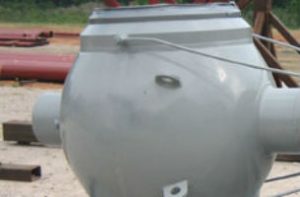 High-temperature pipeline coating by Denso cures quickly to allow for faster backfill
High-temperature pipeline coating by Denso cures quickly to allow for faster backfill
January 2, 2020 REDWIRE is news you can use from leading suppliers. Powered by FRASERS.
Posted by Denso North America Inc
Worldwide Suppliers Of Anti-Corrosion, Waterproofing & Sealing Systems For Pipeline Coatings, Steelwork Protection,... Read more
Subscribe
Free REDWIRE e-newsletter

Protal 7900HT is designed for high temperatures.
Denso North America manufactures liquid coatings for pipelines, including the unique Protal 7900HT. This is a high-temperature pipeline coating that users apply by hand or spray in one coat, in the field or the shop. Its main advantage is fast curing, which enables quick backfill when applied to hot pipes. Protal 7900HT is perfect for girth welds, pipes, fittings, valves, and fabrication, for pipelines operating at temperatures up to 121 degrees Celsius.
High adhesion and low permeability
A VOC-free, 100 per cent solids epoxy coating, Protal 7900HT offers many benefits: high build of up to 1,524 microns in one coat; excellent adhesion; intermittent service temperature of up to 150 degrees Celsius; low permeability; high abrasion resistance; and outstanding self-levelling characteristics. This high-temperature pipeline coating complies with the CSA Z245.30 and AWWA C-210-92 standards, does not shield cathodic protection, and is environmentally safe.
Other specifications for this high-temperature pipeline coating:
- white base component, black hardener, and grey mixed material
- mixing ratio of three parts base to one part hardener in volume
- pot life of 30 minutes at 25 degrees Celsius, or 15 minutes at 36 degrees Celsius
- coverage of 0.7 to 0.9 square metres per litre
- thickness from 635 to 1,524 microns
- adhesion to steel of 3,030 pounds per square inch
For brush application, Denso recommends preparing surfaces by grit blasting to a clean, near-white finish, then stirring the base and hardener, adding hardener to base, and mixing slowly until a constant colour is achieved. Then pour the mix onto the surface and brush, trowel, or roll to the needed mil thickness. For surface temperatures under ten degrees Celsius, preheat the surface with a propane torch or induction coil for a quicker cure.
Spray application also begins with grit blasting and should be conducted with a plural component airless spray unit with a proportioning pump that can mix at a volume ratio of three to one. Consult Denso for the most appropriate equipment for the specific application. A wet-on-wet spray technique should result in a minimum thickness of 635 microns.
To learn more, contact Denso.
Share
Posted by Denso North America Inc
Worldwide Suppliers Of Anti-Corrosion, Waterproofing & Sealing Systems For Pipeline Coatings, Steelwork Protection,... Read more